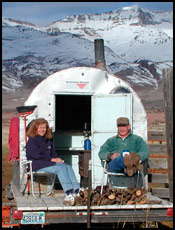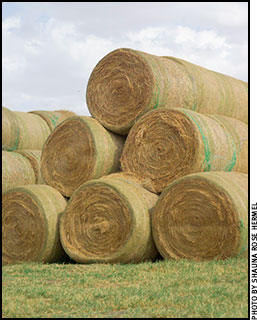
Ron Torell with his wife, Jackie.
Cow Camp Chatter
Shop for nutrients.
Hay prices are skyrocketing. In some instances the price has doubled from what it was just a few short years ago. These escalating prices are primarily due to a nationwide drought that has reduced supply and increased demand for hay, grain and standing forage. The price relationship of protein and energy sources parallel corn and other grain commodities.
Whether you are selling, purchasing or feeding hay, it is important to know what you are dealing with. The best and most appropriate way to accomplish this is to compare price per pound of nutrient, not price per ton of feed. This is when an accurate forage/hay sample and analysis will save/earn you valuable dollars.
Feeds should not be compared by cost per ton, as this is very misleading. When nutrient shopping, you are normally interested in protein and/or energy. When comparing feeds for specific nutrients, the following guidelines assist in determining the best buy. Don’t get caught paying high prices for ingredients used as fillers.
Best hay guidelines
First, determine the dry-matter (DM) content of the feeds to be compared. Do this by multiplying 2,000 pounds (lb.) by the percent of dry matter contained in the feed as determined by laboratory analysis. This will give you the total pounds of dry matter in 1 ton of feed. For example, if a hay sample is 87% dry matter, multiply 2,000 lb. of as-fed hay by 87% (0.87) DM content. The result is 1,740 lb. of actual dry matter.

$250 per ton of as-fed hay with a protein content of 19.55% (DM basis) has a price comparison shopping value of 73.5¢ per lb. of crude protein.
Next, determine the total pounds of a nutrient in the 1,740 lb. of dry matter. Do this by multiplying 1,740 lb. by the percent of the nutrient contained in that feed. For example, if the hay is analyzed at 19.55% crude protein on a DM basis, multiply 1,740 lb. of dry matter ✕ 0.1955 (19.55% crude protein) = 340 lb. of crude protein.
This leaves 1,660 lb. of water, other nutrients and filler contained in 1 ton of as-fed feed (2,000 lb. – 340 lb. of crude protein = 1,660 lb.).
Finally, determine the cost per pound of actual protein. Do this by dividing the ton price of as-fed feed (most feeds are priced as-fed and/or by the ton) by the pounds of actual protein contained in that ton of as-fed feed ($250 per ton ÷ 340 lb. of crude protein = 73.5¢ per lb.).
In the example above, $250 per ton of as-fed hay with a protein content of 19.55% (DM basis) has a price comparison shopping value of 73.5¢ per lb. of crude protein. This same pricing method can be applied when shopping for energy by simply replacing the protein components of the above formula with the energy numbers.
Protein supplements are perhaps the most difficult to evaluate because they can differ in the amount of utilizable protein. Feed supplements such as tubs, liquid and block often contain non-protein nitrogen (NPN) sources such as urea, biuret and others. There is also bypass protein and rumen-degradable protein. NPN sources of protein do not equal natural protein, yet many unsuspecting cattlemen purchase these products assuming they are.
The extent to which NPN is utilized is dependent upon several factors, including the energy content of the ration and the quality of the available forage. The general rule of thumb nutritionists follow for animals consuming a forage-based diet is that no more than one-third of the total protein of the ration should be provided to the animal from NPN sources when adequate energy is contained in the total ration and/or supplement.
For this reason, when you compare feeds on price you need to read the feed-analysis label and remove the NPN portion of the protein for price-comparison purposes. Recognize that if a supplement contains no more than one-third of the protein content as NPN, animals will utilize a portion of the NPN as protein.
Other factors
Factors other than price should also be considered when shopping for feed ingredients. These include but are not limited to:
- Convenience/feed-ability; i.e., feeding blocks or tubs vs. hay or pellets;
- Transportation costs of getting feed to the ranch. Keep in mind it will probably cost the same to transport a load of good hay as it will a load of junk hay;
- Storage facilities at the ranch;
- Cost of feeding the product;
- Availability of the product;
- Consumption amount required to balance the ration;
- Other nutrients required to balance the ration;
- Waste;
- Salt and mineral content;
- Competition when fed (bunk space);
- Opportunity to medicate feed; and
- Worn and broken teeth on blocks.
Even though the price of feedstuffs has increased significantly, the biological nutrient demand of the bovine remains the same. The nutrient demand must be met or reduced production will result.
That’s enough for this month. A special thanks to my wife, Jackie, for her part in writing “Cow Camp Chatter.” As always, if you would like to discuss this article or simply want to talk cows, do not hesitate to contact me at 775-385-7665 or rtbulls@frontier.com.











